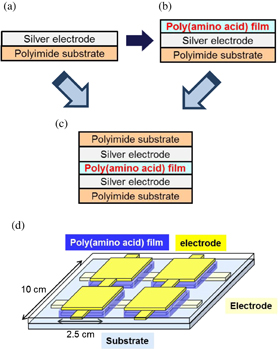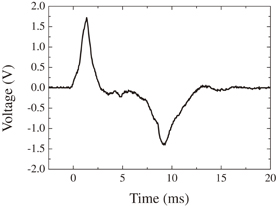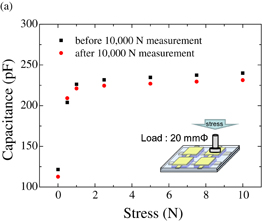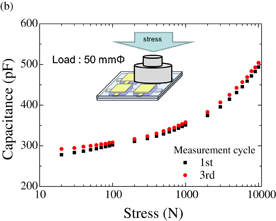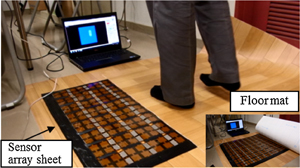Abstract
We report on the device characteristics of a sheetlike flexible pressure sensor array consisting of poly(amino acid)-based piezoelectric elements fabricated on a plastic-film substrate by a printing technique. Poly(amino acid)-based piezoelectric elements were fabricated using poly(amino acid) as the piezoelectric material, silver paste ink as the electrodes, and polyimide sheet as the substrate. When dropping the load of 200 g from a height of 8.5 cm to the piezoelectric element, +1.7 and −1.4 V were observed owing to the displacement of the dipole moment in the poly(amino acid) film. We confirmed that pressures from 0 to 10,000 N were successfully measured from the change in the capacitance of the piezoelectric element, which underwent mechanical strain caused by the pressure application. The flexible pressure sensor element exhibited no noticeable degradation after repeated pressure tests at 10,000 N. Moreover, the spliced large-area pressure sensor sheet successfully detected human-stepping pressure and monitored positional information.
Export citation and abstract BibTeX RIS
1. Introduction
Device fabrication using printing method has received much attention because of its potential advantages, in terms of material, cost saving, high speed, mass production, and low-temperature processes, over the conventional fabrication technology. It is a prospective candidate for fabrication of flexible and/or large-area electronics devices based on plastic film substrates.1–7) Sheetlike large-area sensor arrays are fascinating outcomes of printed electronics, and are expected to be an important component of the infrastructures of an advanced information society.
Large-area pressure sensors that can monitor pressure intensity and/or distribution are applicable to floor sensors,8,9) bed sensors,10,11) sheet sensors,12–14) and vital sign sensors15–17) among others. There are several types of pressure sensor such as the optical fiber, resistance, capacitance, and piezoelectric types. However, existing pressure sensors are expensive and often are not suitable for array fabrication and printing. In addition, the structures of these sensors make it difficult to increase the sensor array size. These problems limit the widespread use of pressure sensors in society. To solve the above problems, we studied the polymer-based piezoelectric sensor from the view point of applicability of the printing process.
There are several kinds of piezoelectric materials. Although ceramic materials such as BaTiO3 and Pb(Zr,Ti)O318,19) have a large piezoelectric effect and are used in many existing piezoelectric devices, these inorganic piezoelectric materials are difficult to use as flexible piezoelectric sensors. On the other hand, polymer-based piezoelectric materials such as poly(vinylidene fluoride) (PVDF)20) are suitable for flexible piezoelectric sensor devices. Most polymer piezoelectric materials need polarization treatment for the piezoelectric effect to be expressed. For example, a PVDF film is stretched in the uniaxial direction for aligning the polymer chain, and then polarized by applying a high voltage at a high temperature. Therefore, piezoelectric polymer films, which need polarization treatment, are difficult to form on an electrode substrate by a printing process.
We focused on an α-helical poly(amino acid) as the piezoelectric polymer material, which, in general, has a large molecular dipole momentum originating from the intramolecular uniaxial alignment of the peptide groups along the main chain.21,22) Owing to the rigid rodlike molecular structure, in-plane self-alignment of the chain axis occurs in the solid films prepared from a polymer solution, consequently providing ferroelectricity and piezoelectricity.23,24) Previously, our research group reported the fabrication of a ferroelectric thin film transistor memory based on a poly(amino acid) film prepared from a polymer solution.25,26) In this study, we report the device characteristics of the all-printed pressure sensor array sheet based on the piezoelectric film fabricated from poly(amino acid) ink.
2. Experimental procedure
2.1. Materials
The poly(amino acid) ink was supplied by Ajinomoto corporation. RA FS 059 (Toyochem) was used as the silver paste ink. The flexible plastic substrate was a polyimide sheet (Du Pont-Toray Kapton®; film thickness, 50 µm).
2.2. Device fabrication
The printed pressure sensor array sheet was fabricated in accordance with the following processes (Fig. 1). (a) The silver paste ink was printed on the polyimide sheet by screen printing, and its electrode pattern was sintered on a hot plate at 150 °C for 1 min and 250 °C for 1 min. The film thickness of the sintered silver electrode was 10 µm. (b) The poly(amino acid) ink was casted on the silver electrode of the (a) substrate and covered the electrode surface of the sensor area. The poly(amino acid) film (film thickness, 80 µm) was obtained by drying overnight in atmosphere at room temperature. (c) The pressure sensor array sheet was fabricated by bonding the (a) silver electrode substrate and (b) poly(amino acid) film substrate, and heated on the hot plate at 150 °C for 30 min. (d) The fabricated pressure sensor array sheet has 4 piezoelectric elements (2 × 2 matrix) in a sheet. The sizes of the sheet and piezoelectric element were 10 × 10 cm2 and 2.5 × 2.5 cm2, respectively.
Fig. 1. Device structure and fabrication processes for the printed pressure sensor array sheet.
Download figure:
Standard image High-resolution image2.3. Measurement
The capacitance of the pressure sensor element was measured using an Agilent 4284A precision LCR meter. A static load was applied to the pressure sensor element using a Shimadzu autograph AGS-X. The sizes of the loads used in the autograph were 20 mmϕ (0–10 N) and 50 mmϕ (20–10,000 N). A Tektronix DPO 7104 digital phosphor oscilloscope was used for the measurement of voltage generated by the piezoelectric effect of the pressure sensor element.
3. Results and discussion
To confirm the piezoelectricity of the printed pressure sensor element, we measured the voltage generated by dropping a load of 200 g from a height of 8.5 cm to the sensor element placed on a desk. Figure 2 shows the result of voltage measurement. When the load collided with and bounced from the sensor element, the voltages of +1.7 and −1.4 V were observed owing to the displacement of the dipole moment in the poly(amino acid) film. Ideally, the plus and minus peak voltages generated by the piezoelectric effect should be the same. Indeed, the peak voltage depends on the amount of momentary displacement. In this case, the minus peak voltage was smaller than the plus peak voltage because collision energy was absorbed by elastic deformation of flexible materials in the sensor element.
Fig. 2. Output voltage of the printed pressure sensor element generated by dropping the load of 200 g from a height of 8.5 cm to the sensor element placed on a desk.
Download figure:
Standard image High-resolution imageThis result clearly indicated that the poly(amino acid) film actually became a piezoelectric polymer film without stretching and polarization. The rigid rodlike α-helix poly(amino acid) has a large dipole moment along its molecular axis, and its molecular axes are spontaneously oriented during drying. In the case of the high-molecular-weight poly(amino acid) film, its molecular axes are oriented in parallel direction to the substrate surface.27) The poly(amino acid) ink used in this work was designed to contain both perpendicular and parallel components in the direction of dipole moment after film formation. Thus, the printed poly(amino acid)-based sensor element expressed the piezoelectric property in the perpendicular direction.
Although the voltage generated from the piezoelectric effect is suitable for detection of momentary pressure changes, it is not suitable for detection of static pressure because the voltage decays rapidly. For the applications of pressure sensor sheet, it should be capable of detecting static pressure continuously. Therefore, we used the capacitance change of the sensor element for static pressure detection.
To confirm the pressure-sensing property of the printed sensor element, we measured the capacitance change of the element under various stresses. The capacitance changes of the sensor element pressed by various static loads are shown in Figs. 3(a) and 3(b). Initially, the capacitance of the sensor element was almost 120 pF. When the sensor element was pressed at 0.5 N, its capacitance markedly increased from 120 to 200 pF [Fig. 3(a), black squares]. In the sensor element, electric charge accumulates on the electrode surface as a form of charge compensation for the spontaneously polarized poly(amino acid) film. When pressure is applied to the sensor element, the direction of the dipole moment of the poly(amino acid) changes. Then, electric charge accumulated on electrode is increased owing to the charge compensation effect. Although the capacitance of the sensor element gradually increased with increasing stress, the amount of capacitance changes of the sensor element decreased. This nonlinear characteristic is attributed to elastic deformation of the flexible sensor sheet and to the repulsion force from the poly(amino acid) film, silver electrode, and polyimide substrate in the sensor sheet. On the other hand, the capacitance of the sensor element still changed at 10,000 N [Fig. 3(b), black squares]. 10,000 N is almost equal to a weight of 1,000 kg. These capacitance–stress characteristics did not change during the three measurement cycles [Fig. 3(b), red circles]. Moreover, the printed sensor element still retained its pressure sensitivity in the low-pressure region [Fig. 3(a), red circles] after three cycles of 10,000 N measurements. These results clearly indicate that this flexible printed pressure sensor sheet could detect static pressure from 0 to 10,000 N without degradation. This was due to the elastic deformation of the pressure sensor sheet consisting of flexible materials. The high robustness is one of the advantages of flexible devices.
Download figure:
Standard image High-resolution imageFig. 3. Dependence of capacitance on applied stress from (a) 0–10 N and (b) 20–10,000 N for the printed pressure sensor element.
Download figure:
Standard image High-resolution imageTo compare the pressure sensitivity of the printed pressure sensor element with that of a commercialized flexible piezoelectric element, we used the PVDF-based piezoelectric element. The structure of the PVDF element was almost the same as that of the pressure sensor element. Both sides of the PVDF film (film thickness, 28 µm) were coated with the silver electrode. One side of the PVDF element was laminated with polyethylene terephthalate film (film thickness, 12.7 µm). We measured the capacitance changes of both elements in the initial, loading, and bending states. The results are listed in Table I.
Table I. Capacitance of the printed pressure sensor element and PVDF element measured in initial, loading, and bending states. The sensor element was pressed by the load (18 mmϕ, 410 g) in the loading state, and it was bent in a semicircle 20 mm in diameter in the bending state. The active electrode area of the PVDF element is 1.2 × 3 cm2.
| Capacitance of the pressure sensor element (pF·cm−2) | Capacitance of the PVDF element (pF·cm−2) | |
|---|---|---|
| Initial state | 26 | 325 |
| Loading state | 50 (Δ = 24) | 326 (Δ = 1) |
| Bending state | 55 (Δ = 29) | 332 (Δ = 7) |
The initial capacitances of the pressure sensor element and PVDF element were 26 and 325 pF/cm2, respectively. When the sensor element was pressed by the load (18 mmϕ, 410 g), its capacitance increased to 50 pF/cm2 (ΔCP = 24 pF/cm2). Moreover, the sensor element exhibited a large capacitance change (ΔCP = 29 pF/cm2) when it was bent in a semicircle 20 mm in diameter. In both cases, the pressure sensor element showed almost the same capacitance changes. On the other hand, the PVDF element showed different capacitance changes under both conditions. The capacitance change of the PVDF element in the loading and bending states were 1 and 7 pF/cm2, respectively. In general, the polarized PVDF film has a high piezoelectric sensitivity in parallel with its film plane. Although the loading state included only vertical pressure, the bending state included both vertical and horizontal pressures. Therefore, the PVDF element showed a larger capacitance change in the bending state than in the loading state. These differences between the pressure sensor element and the PVDF element were due to the difference in the directions of polarization. From these results, it was clearly indicated that the pressure sensor element has a high pressure sensitivity in the perpendicular direction of the sheet.
It was obvious that the printed pressure sensor element has high pressure durability and sensitivity. Although the polarized PVDF loses its piezoelectric effect in an environment with a temperature higher than the polarization treatment temperature, the printed pressure sensor element still retains better piezoelectric effect after the fabrication at 150 °C. These characteristics of the printed pressure sensor element are effective for pressure detection applications in a living environment.
To fabricate a large-area pressure sensor such as a floor sensor, we tried to enlarge the printed pressure sensor array sheet. We successfully fabricated a 80 × 80 cm2 (16 × 16 matrix) large-area pressure sensor by splicing the 10 × 10 cm2 (2 × 2 matrix) small printed pressure sensor array sheet. This enlargement technique made it possible to fabricate the large-area pressure sensor without the need for large-scale facilities and to easily change the sensor layout and the size of the sheet.
Figure 4 shows the human-stepping pressure detection experiment in which changes in the positional information caused by roaming on the large-area sensor sheet were monitored. The sensor elements were scanned at 40 Hz and the detected capacitance changes were displayed on a PC monitor as color changes. When a male subject walked on the floor sensor covered with a floor mat, the capacitance of the sensor elements under foot were changed by body weight, and the position of the male subject was displayed on the PC monitor. We succeeded in tracking a person walking around on the spliced large-area pressure sensor sheet.
Fig. 4. Picture of the human-stepping pressure detection experiment using the large-area pressure sensor array sheet. The right-half of the sensor sheet was covered with the floor mat, on which an adult male walked around ordinarily. The uncovered part of the sensor sheet is shown in the inset picture.
Download figure:
Standard image High-resolution image4. Conclusions
In this work, we developed an all-printed pressure sensor array sheet and applied it to a large-area pressure sensor sheet. The printed pressure sensor elements showed high pressure sensitivity from 0 to 10,000 N. After three cycles of 10,000 N measurements, the printed flexible pressure sensor elements still retained pressure sensitivity without degradation. Moreover, the spliced large-area pressure sensor sheet successfully detected human-stepping pressure and monitored positional information. These elements are suitable for large-area pressure-sensing applications in a living environment.
Acknowledgement
The authors would like to thank Ajinomoto Co., Inc. for supplying the poly(amino acid) samples.


